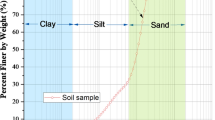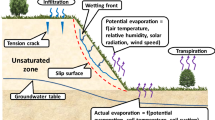Abstract
Constitutive models in the literature for creep of frozen soil are based on the direct use of time counted from the onset of creep. An explicit time dependence in a constitutive equation violates the principles of rational mechanics. No change in stress or temperature is allowed for during creep, using the time-based formulations. Moreover, the existing descriptions need much verification and improvement on the experimental side as well. Creep behaviour of artificially frozen sand was evaluated experimentally. Novel testing methods were used, and new insights into the creep behaviour of frozen soil were gained. Creep rate under uniaxial compression was examined with different kinds of interruptions, like unloadings or overloadings. Experimental creep curves were presented as functions of creep strain. They were brought to a dimensionless form which describes the creep universally, despite changes in stress or temperature. Possible anisotropy of frozen soil was revealed in the creep tests on cubic samples with changes of the loading direction. Using the particle image velocimetry (PIV) technique, information on the lateral deformation and the uniformity of creep were obtained. Volumetric creep of unsaturated frozen soil under isotropic compression was demonstrated to be due to the presence of air bubbles only.




























Similar content being viewed by others
Data availability
All laboratory data can be obtained on an e-mail request.
References
Chupin O, Rechenmacher A, Abedi S (2011) Finite strain analysis of nonuniform deformation inside shear bands in sands. Int J Numer Anal Meth Geomech 36(14):1651–1666. https://doi.org/10.1002/nag.1071
Cudmani R (2006) An elastic-viscoplastic model for frozen soils. In: Triantafyllidis T (ed) Numerical modelling of construction processes in geotechnical engineering for urban environment. Taylor & Francis, Milton Park, pp 177–183
Cudmani R, Yan W, Schindler U (2022) A constitutive model for the simulation of temperature-, stress- and rate-dependent behaviour of frozen granular soils. Géotechnique. https://doi.org/10.1680/jgeot.21.00012
Domaschuk L, Shields D, Rahman M (1991) A model for attenuating creep of frozen sand. Cold Reg Sci Technol 19:145–161
Eckardt H (1979) Creep behaviour of frozen soils in uniaxial compression tests. Eng Geol 13(1):185–195. https://doi.org/10.1016/0013-7952(79)90031-0
Eckardt H (1979b) Tragverhalten gefrorener erdkörper. PhD thesis, Institut für Boden- und Felsmechanik, Universität Fridericiana in Karlsruhe, Heft Nr. 81
Eckardt H (1982) Creep tests with frozen soils under uniaxial tension and uniaxial compression. In: Proceedings of the 4th Canadian permafrost conference, pp 394–405
Fender K (2017) Low probability - high impact. Rail Engineer pp 34–38
Fuentes Lacouture W (2014) Contributions in mechanical modelling of fill materials. Veröffentlichungen des IBF/KIT, Karlsruher Institut für Technologie, Heft, p 179
Hassner T, Liu C (2016) Dense image correspondences for computer vision. Springer, Switzerland
Ikeda-Fukazawa T, Fukumizu K, Kawamura K, Aoki S, Nakazawa T, Hondoh T (2005) Effects of molecular diffusion on trapped gas composition in polar ice cores. Earth Planet Sci Lett 229(3):183–192. https://doi.org/10.1016/j.epsl.2004.11.011
Jones S, Johari G (1977) Effect of hydrostatic pressure on air bubbles in ice. Isotopes and impurities in snow and ice, IAHS Redbooks, Gentbrugge, Belgium 118:23–28
Knittel L (2020) Verhalten granularer böden unter mehrdimensionaler zyklischer beanspruchung. Veröffentlichungen des IBF/KIT, Karlsruher Institut für Technologie, Heft, p 188
Liu Z, Yu X (2011) Coupled thermo-hydro-mechanical model for porous materials under frost action: theory and implementation. Acta Geotech 6:51–65. https://doi.org/10.1007/s11440-011-0135-6
Ma L, Qi J, Yu F, Yao X (2015) Experimental study on variability in mechanical properties of a frozen sand as determined in triaxial compression tests. Acta Geotech. https://doi.org/10.1007/s11440-015-0391-y
Merz K, Vrettos C (2015) Aktuelle Forschung in der Bodenmechanik, chap Materialverhalten von gefrorenem Sand aus Triaxialversuchen an kubischen Proben, pp 101–117. https://doi.org/10.1007/978-3-662-45991-1_6
Orth W (1986) Gefrorener Sand als Werkstoff: Elementversuche und Materialmodell. PhD thesis, Institut für Boden- und Felsmechanik, Universität Fridericiana in Karlsruhe, Heft Nr. 100
Orth W (2018) Grundbau-Taschenbuch Teil 2, John Wiley & Sons, chap 2.4 Bodenvereisung, pp 299–373. https://doi.org/10.1002/9783433607312.ch4
Orth W, Meissner H (1982) Long-term creep of frozen soil in uniaxial and triaxial tests. In: Proc 3rdn Int Symp on Ground Freezing, Hanover, N.H., USA
Osterkamp T, Burn C (2015) Cryosphere permafrost. In: North G, Pyle J, Zhang F (eds) Encyclopedia of atmospheric sciences, 2nd edn. Academic Press, Oxford, pp 208–216
Srokosz P, Bujko M, Bocheńska M, Ossowski R (2021) Optical flow method for measuring deformation of soil specimen subjected to torsional shearing. Measurement 174:109064. https://doi.org/10.1016/j.measurement.2021.109064
Staroszczyk R (2019) Ice mechanics for geophysical and civil engineering applications. Springer, Switzerland
Staszewska K (2022) Towards a constitutive description of creep in frozen soils. Dissertation, Gdańsk University of Technology, https://doi.org/10.13140/RG.2.2.35977.11364
Šuklje L (1957) The analysis of the consolidation process by the isotaches method. In: Proceedings 4th international conference on soil mechanics and foundation engineering, Butterworths Scientific Publications, pp 200–206
Ting J (1981) The creep of frozen sands: qualitative and quantitative models. Massachusetts Inst of Tech Report
Ting J (1983) On the nature of the minimum creep rate - time correlation for soil, ice, and frozen soil. Can Geotech J 20:176–182. https://doi.org/10.1139/t83-017
Vogelsang J (2017) Untersuchungen zu den mechanismen der pfahlrammung. Veröffentlichungen des IBF/KIT, Karlsruher Institut für Technologie, Heft, p 182
White D, Take W, Bolton M (2003) Soil deformation measurement using particle image velocimetry (piv) and photogrammetry. Géotechnique 53(7):619–631. https://doi.org/10.1680/geot.2003.53.7.619
Wichtmann T (2016) Soil behaviour under cyclic loading - experimental observations, constitutive description and applications. Veröffentlichungen des IBF/KIT, Karlsruher Institut für Technologie, Heft Nr 181 (habilitation)
Wolfram Research Inc (2021) Mathematica
Xu X, Wang Y, Zhenhua Y, Zhang H (2017) Effect of temperature and strain rate on mechanical characteristics and constitutive model of frozen helin loess. Cold Reg Sci Technol. https://doi.org/10.1016/j.coldregions.2017.01.010
Yao X, Wang W, Zhang M, Wang S, Wang L (2021) Strain localization of a frozen sand under different test conditions. Cold Reg Sci Technol 183:103226. https://doi.org/10.1016/j.coldregions.2021.103226
Zachert H (2015) Zur gebrauchtauglichkeit von gründungen für offschore-windenergieanlagen. Veröffentlichungen des IBF/KIT, Karlsruher Institut für Technologie, Heft, p 180
Zhou G, Zhou Y, Hu K, Wang Y, Shang X (2018) Separate-ice frost heave model for one-dimensional soil freezing process. Acta Geotech. https://doi.org/10.1007/s11440-017-0579-4
Zürn J (2021) Volumetrisches Kriechverhalten in gefrorenem Sand. Karlsruher Institut für Technologie
Zürn J (2022) Volumetrisches und ödometrisches Kriechverhalten in gefrorenem Sand. Master’s thesis, Karlsruher Institut für Technologie
Author information
Authors and Affiliations
Corresponding author
Ethics declarations
Code availability
The relevant packages for the algebra programme mathematica are available on an e-mail request.
Additional information
Publisher's Note
Springer Nature remains neutral with regard to jurisdictional claims in published maps and institutional affiliations.
Rights and permissions
Springer Nature or its licensor (e.g. a society or other partner) holds exclusive rights to this article under a publishing agreement with the author(s) or other rightsholder(s); author self-archiving of the accepted manuscript version of this article is solely governed by the terms of such publishing agreement and applicable law.
About this article
Cite this article
Staszewska, K., Niemunis, A. & Cudny, M. Experimental observations on the creep behaviour of frozen soil. Acta Geotech. (2024). https://doi.org/10.1007/s11440-024-02253-8
Received:
Accepted:
Published:
DOI: https://doi.org/10.1007/s11440-024-02253-8




